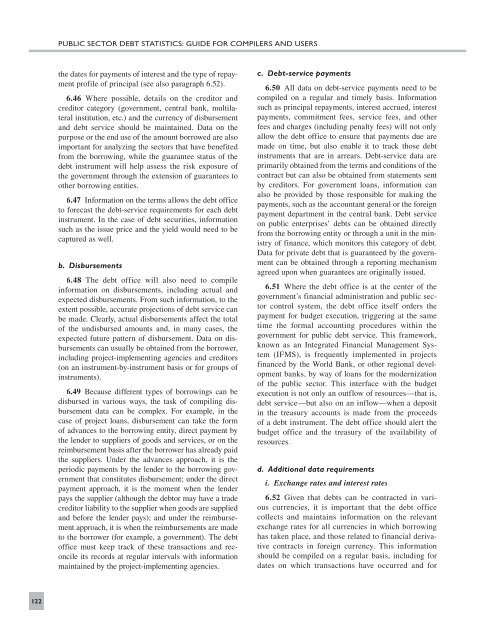Data Collection, Compilation, and Dissemination - Task Force on ...
Data Collection, Compilation, and Dissemination - Task Force on ...
Data Collection, Compilation, and Dissemination - Task Force on ...
You also want an ePaper? Increase the reach of your titles
YUMPU automatically turns print PDFs into web optimized ePapers that Google loves.
122<br />
PUBLIC SECTOR DEBT STATISTICS: GUIDE FOR COMPILERS AND USERS<br />
the dates for payments of interest <str<strong>on</strong>g>and</str<strong>on</strong>g> the type of repayment<br />
profile of principal (see also para graph 6.52).<br />
6.46 Where possible, details <strong>on</strong> the creditor <str<strong>on</strong>g>and</str<strong>on</strong>g><br />
creditor category (government, central bank, multilateral<br />
instituti<strong>on</strong>, etc.) <str<strong>on</strong>g>and</str<strong>on</strong>g> the currency of disburse ment<br />
<str<strong>on</strong>g>and</str<strong>on</strong>g> debt service should be maintained. <str<strong>on</strong>g>Data</str<strong>on</strong>g> <strong>on</strong> the<br />
purpose or the end use of the amount borrowed are also<br />
important for analyzing the sectors that have benefited<br />
from the borrowing, while the guarantee status of the<br />
debt instrument will help assess the risk exposure of<br />
the government through the extensi<strong>on</strong> of guarantees to<br />
other borrowing entities.<br />
6.47 Informati<strong>on</strong> <strong>on</strong> the terms allows the debt office<br />
to forecast the debt-service requirements for each debt<br />
instrument. In the case of debt securities, informati<strong>on</strong><br />
such as the issue price <str<strong>on</strong>g>and</str<strong>on</strong>g> the yield would need to be<br />
captured as well.<br />
b. Disbursements<br />
6.48 The debt office will also need to compile<br />
in formati<strong>on</strong> <strong>on</strong> disbursements, including actual <str<strong>on</strong>g>and</str<strong>on</strong>g><br />
expected disbursements. From such informati<strong>on</strong>, to the<br />
extent possible, accurate projecti<strong>on</strong>s of debt ser vice can<br />
be made. Clearly, actual disbursements affect the total<br />
of the undisbursed amounts <str<strong>on</strong>g>and</str<strong>on</strong>g>, in many cases, the<br />
expected future pattern of disbursement. <str<strong>on</strong>g>Data</str<strong>on</strong>g> <strong>on</strong> disbursements<br />
can usually be obtained from the borrower,<br />
including project-implementing agen cies <str<strong>on</strong>g>and</str<strong>on</strong>g> creditors<br />
(<strong>on</strong> an instrument-by-instrument basis or for groups of<br />
instruments).<br />
6.49 Because different types of borrowings can be<br />
disbursed in various ways, the task of compiling disbursement<br />
data can be complex. For example, in the<br />
case of project loans, disbursement can take the form<br />
of advances to the borrowing entity, direct payment by<br />
the lender to suppliers of goods <str<strong>on</strong>g>and</str<strong>on</strong>g> services, or <strong>on</strong> the<br />
reimbursement basis after the borrower has already paid<br />
the suppliers. Under the advances approach, it is the<br />
periodic payments by the lender to the borrowing government<br />
that c<strong>on</strong>stitutes disbursement; under the direct<br />
payment approach, it is the moment when the lender<br />
pays the supplier (although the debtor may have a trade<br />
creditor liability to the supplier when goods are supplied<br />
<str<strong>on</strong>g>and</str<strong>on</strong>g> before the lender pays); <str<strong>on</strong>g>and</str<strong>on</strong>g> under the reimbursement<br />
approach, it is when the re imbursements are made<br />
to the borrower (for example, a government). The debt<br />
office must keep track of these transacti<strong>on</strong>s <str<strong>on</strong>g>and</str<strong>on</strong>g> rec<strong>on</strong>cile<br />
its records at regular intervals with informati<strong>on</strong><br />
maintained by the project-implementing agencies.<br />
c. Debt-service payments<br />
6.50 All data <strong>on</strong> debt-service payments need to be<br />
compiled <strong>on</strong> a regular <str<strong>on</strong>g>and</str<strong>on</strong>g> timely basis. Informati<strong>on</strong><br />
such as principal repayments, interest accrued, interest<br />
payments, commitment fees, service fees, <str<strong>on</strong>g>and</str<strong>on</strong>g> other<br />
fees <str<strong>on</strong>g>and</str<strong>on</strong>g> charges (including penalty fees) will not <strong>on</strong>ly<br />
allow the debt office to ensure that payments due are<br />
made <strong>on</strong> time, but also enable it to track those debt<br />
instruments that are in arrears. Debt-service data are<br />
primarily obtained from the terms <str<strong>on</strong>g>and</str<strong>on</strong>g> c<strong>on</strong>diti<strong>on</strong>s of the<br />
c<strong>on</strong>tract but can also be obtained from statements sent<br />
by creditors. For government loans, informati<strong>on</strong> can<br />
also be provided by those resp<strong>on</strong>sible for making the<br />
payments, such as the accountant general or the foreign<br />
payment department in the central bank. Debt service<br />
<strong>on</strong> public enterprises’ debts can be obtained directly<br />
from the borrowing entity or through a unit in the ministry<br />
of finance, which m<strong>on</strong>itors this category of debt.<br />
<str<strong>on</strong>g>Data</str<strong>on</strong>g> for private debt that is guaranteed by the government<br />
can be obtained through a reporting me chanism<br />
agreed up<strong>on</strong> when guarantees are originally issued.<br />
6.51 Where the debt office is at the center of the<br />
government’s financial administrati<strong>on</strong> <str<strong>on</strong>g>and</str<strong>on</strong>g> public sector<br />
c<strong>on</strong>trol system, the debt office itself orders the<br />
payment for budget executi<strong>on</strong>, triggering at the same<br />
time the formal accounting procedures within the<br />
government for public debt service. This framework,<br />
known as an Integrated Financial Management System<br />
(IFMS), is frequently implemented in projects<br />
financed by the World Bank, or other regi<strong>on</strong>al development<br />
banks, by way of loans for the modernizati<strong>on</strong><br />
of the public sector. This interface with the budget<br />
executi<strong>on</strong> is not <strong>on</strong>ly an outflow of resources—that is,<br />
debt service—but also <strong>on</strong> an inflow—when a deposit<br />
in the treasury accounts is made from the proceeds<br />
of a debt instrument. The debt office should alert the<br />
budget office <str<strong>on</strong>g>and</str<strong>on</strong>g> the treasury of the availability of<br />
re sources.<br />
d. Additi<strong>on</strong>al data requirements<br />
i. Exchange rates <str<strong>on</strong>g>and</str<strong>on</strong>g> interest rates<br />
6.52 Given that debts can be c<strong>on</strong>tracted in various<br />
currencies, it is important that the debt office<br />
collects <str<strong>on</strong>g>and</str<strong>on</strong>g> maintains informati<strong>on</strong> <strong>on</strong> the relevant<br />
exchange rates for all currencies in which borrowing<br />
has taken place, <str<strong>on</strong>g>and</str<strong>on</strong>g> those related to financial derivative<br />
c<strong>on</strong> tracts in foreign currency. This informati<strong>on</strong><br />
should be compiled <strong>on</strong> a regular basis, including for<br />
dates <strong>on</strong> which transacti<strong>on</strong>s have occurred <str<strong>on</strong>g>and</str<strong>on</strong>g> for


